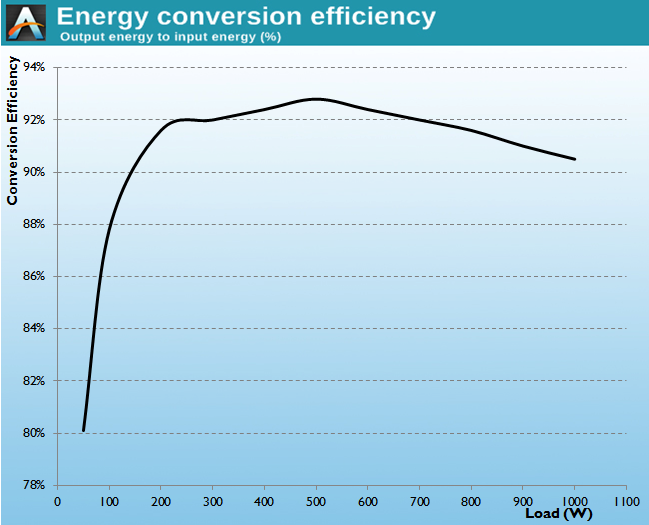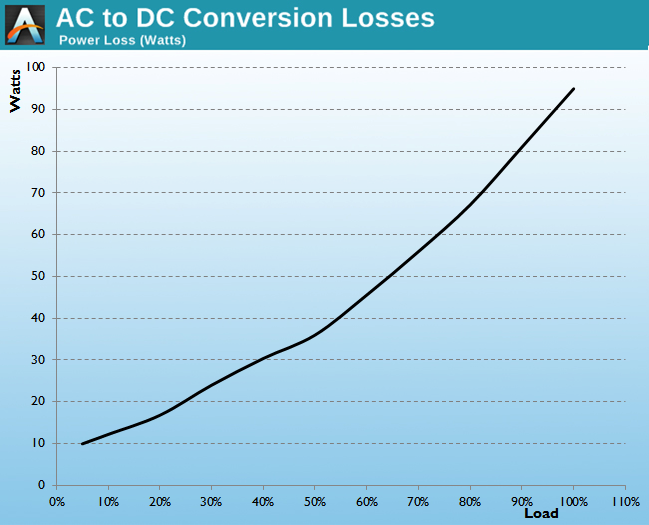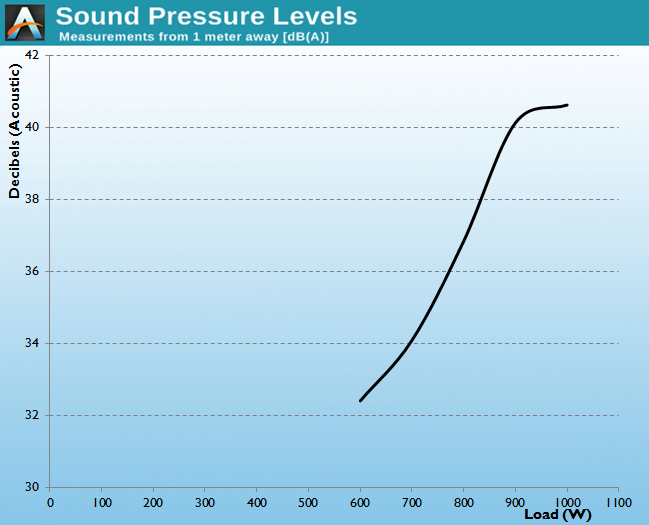The Corsair RM1000x and RM1000i 1000W Power Supply Review
by E. Fylladitakis on September 30, 2015 8:00 AM EST- Posted in
- Cases/Cooling/PSUs
- Corsair
- RM Series
- Corsair Link
Cold Test Results
For the testing of PSUs, we are using high precision electronic loads with a maximum power draw of 2700 Watts, a Rigol DS5042M 40 MHz oscilloscope, an Extech 380803 power analyzer, two high precision UNI-T UT-325 digital thermometers, an Extech HD600 SPL meter, a self-designed hotbox and various other bits and parts. For a thorough explanation of our testing methodology and more details on our equipment, please refer to our How We Test PSUs - 2014 Pipeline post.
Note: As the RM1000i and the RM1000x are technically identical, their performance during our testing naturally was identical as well. As such, one set of results is displayed in this review for clarity.
The electrical efficiency of the RM1000i/RM1000x is very stable and easily meets the 80Plus Gold efficiency certification standards. In fact, the units went beyond 80Plus Gold and reached 80Plus Platinum efficiency standards during our testing. However, that level is efficiency is was reached using a 230VAC input, therefore the 115VAC input used for 80Plus compliance testing could drop the efficiency below the 80Plus Platinum limits at 50% or 100% load.
The units have a maximum conversion efficiency of 92.8% at 50% load and an average of 91.8% within the nominal load range (20% to 100% of the unit's capacity). It is worthwhile to mention that the older RM1000 had a higher peak efficiency at 50% load, but lower overall efficiency. Corsair also improved the low load efficiency in comparison to the RM1000, bringing it up to 87.8% at 10% load and 80.1% at 5% load.
With the RM1000i/RM1000x operating outside our hotbox, the load had to reach 560 Watts before the fan even started spinning. The thermal performance of the newer models is clearly superior to that of the original RM1000 and astonishing for PSUs with that kind of power output, especially at lower loadings, where the fan is still not spinning. Once the fan starts, it remains practically inaudible. As the load increases however, the fan's speed will increase to meet the increasing cooling demands. The fan becomes clearly audible when the load is greater than about 800 Watts.















47 Comments
View All Comments
jonnyGURU - Thursday, October 1, 2015 - link
Uhhh.... "Excited"? I was simply answering his question.elforeign - Wednesday, September 30, 2015 - link
I can vouch for the quality of this product, the RMi1000W in particular. I have had one since late July when I got it for my 24/7 BOINC Crunching rig. It powers my overclocked i5 and my 2 GTX 970's along with the other components in the system, SSD, HDD, 110i GT AIO etc. The ambient temps in my home are around 22c and thus, even when my system is pulling ~600watts the fan does not turn on because the PSU itself is not heating up that much even under load. Also, the efficiency meter from the Link interface marks around 91.7%The only knock one can give this PSU is the fact that the EPS, PCIE and ATX power cables are rather rigid and thick. It took some work to get the ATX cable into the motherboard. I brought up this complaint to Corsair. As of yesterday, Cablemod is now offering a set of EPS/PCIE/ATX individually sleeved cables for this PSU that I plan to purchase.
LaRock0wns - Wednesday, September 30, 2015 - link
For anybody going to get or make custom cables for this PSU, Corsair changed the connector for the ATX 24-pin cable that plugs in to the PSU. The PSU is a 18 + 10 pin connector instead of the standard 14 + 10 pin.HOOfan 1 - Wednesday, September 30, 2015 - link
They also have capacitors on the cables to aid in ripple suppression...so getting custom cables would give you different results from what is shown in the reviewlozikosaz - Wednesday, September 30, 2015 - link
Aren't capacitors useless in interior cables, which use direct current?AnnihilatorX - Thursday, October 1, 2015 - link
It will help suppress high frequency noise.DanNeely - Wednesday, September 30, 2015 - link
I've seen the 18+10 connector on a number of high end modular PSUs over the last year or so; I suspect it's the ODM's design not corsairs. Elsewhere I was told that the extra wires are used for voltage monitoring at the mobo end to actively adjust for any voltage drop.jonnyGURU - Wednesday, September 30, 2015 - link
It's not the ODM design. The extra 4-pins (actually, 3. But you can't have an odd number of pins on a connector) are for +12V sense, +5V sense and extra ground. Seasonic and Super Flower have been using this method in the past to improve voltage regulation. Corsair started doing this recently as well for the same reason.To address the concern of using cables without sense and caps: You can do it, but you'll end up with the same level of voltage regulation and ripple suppression performance as an HXi.
extide - Wednesday, September 30, 2015 - link
Cant believe it's taken this long for high end PSU's to implement separate sense lines. Any decent lab grade PSU has had that for decades, lol.jonnyGURU - Thursday, October 1, 2015 - link
Correct!But it's a cost adder and since it's only something you'll see in reviews and pretty much any decent PSU is well within Intel's (sloppy) ATX spec, it's not very common.